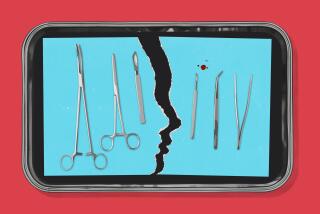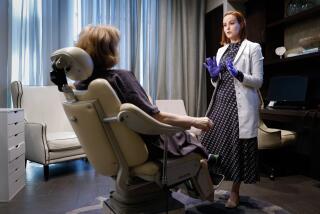Putting Extra Fat in Its Place : Health: Implant restrictions are spurring a rise in fat transplants. But critics warn that using excess cells from thighs to pad breasts may result in lumps that mimic tumors and foul up mammograms.
- Share via
Using a medical procedure that is gaining in popularity, increasing numbers of are having their breasts enlarged with excess fat liposuctioned from other body areas.
Although it may sound appealing--liposuction plus breast augmentation, all in one session--many doctors and two major medical organizations have warned that the procedure is potentially dangerous. The transplanted fat cells usually die, they say, producing scars or lumps that may interfere with an accurate mammogram reading.
But a handful of doctors nationwide who perform the augmentation--including several in California--contend that it is safe and effective.
Beverly Hills plastic surgeon Mel Bircoll, who says he pioneered fat transplantation in 1979, says he has had a wonderful experience with it. “Fat grafting itself is not a new procedure, which is why it’s surprising to me that it has met such resistance.”
Still, until studies clearly establish the risks and benefits of the method--called autologous fat transplantation--experts are likely to disagree on its value.
And consumers will probably continue to seek it, several physicians concede.
“It’s easy, and that’s always tempting,” says Dr. Richard Mladick, a Virginia Beach, Va., plastic surgeon who is an authority on the issue. “But the caution I would give to everyone is that no doctor can say this will work for you and stay permanently. The results are totally unpredictable.”
Since the mid-1980s, the procedure has been used primarily to fill in facial wrinkles and scars, to increase the fullness of lips and to plump up aging skin during a face lift. The safety of these uses is not debated, because lumps or scars under facial skin do not cause medical problems.
The current controversy centers strictly on fat injection in the breasts, which has become more popular since the Food and Drug Administration earlier this year restricted the use of silicone gel implants. Experts estimate the number of women who have undergone the fat transplants to be small, perhaps a few hundred.
Nonetheless, “the desire for augmentation isn’t going to go away,” says Nancy Kobus, a spokeswoman for the American Society for Aesthetic Plastic Surgery, which recently cautioned against fat transplants for increasing breast size. The American Society of Plastic and Reconstructive Surgeons also “strongly condemns” the procedure.
According to Kobus, women who want larger breasts have found their options severely limited since the restrictions on silicone implants. She says many women reject saline implants--currently the only procedure widely available--because they can break or leak, causing the breasts to suddenly deflate. Similarly, silicone implants were removed from the market because of unwanted side effects, such as the hardening of breast tissue and leakage.
One doctor, James Fulton of Newport Beach, says some of his patients have had their silicone implants removed and have later undergone fat transplants.
For example, Susan (not her real name) had two sets of silicone implants, both of which caused hardening of the breast tissue. After the implants were removed the second time, Susan, 51, waited six months for healing and then had a fat transplant. In the three years since the surgery, Susan says, her breasts have maintained their fullness.
“I would never have another silicone implant,” she says in an article by Fulton, soon to be published in the Journal of Cosmetic Surgery. “The (transplant) looks and feels more natural. Recovery time was less, and it was less painful than a silicone implant.”
Susan’s surgery, performed in Fulton’s office, was uncomplicated: The procedure usually takes less than an hour, and costs range from $4,500 to $7,000. With the patient anesthetized, the doctor removes unwanted fat--usually from the buttocks, abdomen or thighs--with a syringe or liposuction device.
The fat is then “washed” of blood and oils, a step Fulton says is crucial to success. Next, seven to 14 ounces of the yellowish fat cells are injected under the breasts’ skin.
The improvements are usually modest, Fulton says, with breast size increasing from an A cup to a B, or a B to a C.
“We spread the fat around in the upper quadrant (of the breast),” Fulton says. “If you don’t do an actual measurement, you could have the illusion that it disappears. But it spreads around in the breast. It doesn’t look as projectile as implants.”
But critics argue that most of the fat eventually disappears. For unknown reasons, they say, the transplanted fat cells die, liquefy and are absorbed by the body. The cells can also calcify, forming the lumps that may be mistaken for tumors on mammograms.
“That’s a huge amount of fat that is injected. It is only logical that some of this fat would produce calcification,” Mladick says.
In addition, calcifications cannot be removed, says Dr. Neal Handel of the Breast Center in Van Nuys.
“The calcifications are irreversible,” he says. “What I think is terrible is when something makes it more difficult to read a mammogram.”
But practitioners say most of the fat remains if the procedure is performed correctly.
If the fat is placed just beneath the skin but not directly into the breast tissue, Bircoll says, calcifications are not a problem. He estimates that only about 1% to 4% of patients develop calcifications.
In Fulton’s study, meanwhile, 20 patients were followed for up to five years after surgery. The patients were measured to show how much fat had been retained, and they also had regular mammograms.
On average, Fulton found, 71% of the transplanted fat survived. Two women had minor calcification that, he said, could occur with any type of breast surgery.
“The advantages are that it’s your tissue, and after 30 days it develops its own blood supply. You do lose (some) fat, but after that it stays stable,” Fulton says.
Doctors who have experienced poor results with the procedure probably do not “wash” the fat cells first, he says: “The problem is how to collect the fat. If there is blood present, it causes inflammation and eats up the fat. I’ve seen it demonstrated where a doctor will inject a mixture of fat and blood and wonder why it all goes away. Part of (the success) is technique.”
Bircoll also dismisses critics, saying, “Most of these people have no experience with the operation. I feel my argument (for its safety) is so clear and simple, these doctors will come around.”
“They finally came around on liposuction,” he says. “Liposuction got just as much negative (publicity) when it was started.”
Autologous Fat Transplantation
Fat can be suction from one part of the body and injected in another area that needs more fullness. This procedure has been popular in the past decade to correct facial deformities or sagging. It is controversial, however, when used for breast augmentation.
HERE IS HOW IT WORKS:
1. Fat is removed from one part of the body--usually the abdomen, buttocks or thighs--by liposuction.
2. Fat is “washed” of blood and oils.
3. The purified fat is then injected into the breasts or other areas of the body where fullness is desired (lips, forehead wrinkles or laugh lines around mouth, under the skin during a face lift.)
The Good: The outpatient procedure takes less than an hour.
The Bad: The cost is steep, from $4,500 to $7,000.
The Unknown: Critics say the transplanted fat disappears in six months. Proponents say 70% of the fat is retained permanently.





